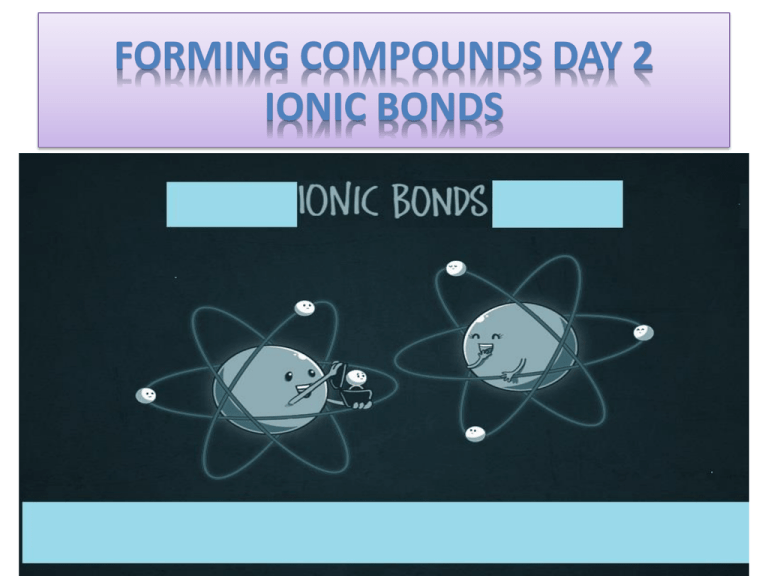Forming compounds day 2 Ionic Bonds
advertisement

FORMING COMPOUNDS DAY 2 IONIC BONDS IONS •Ion: an atom gains or loses electrons Two types: •Anions: Atoms that gain electrons. Anions have a NEGATIVE charge •Cations: atoms that lose electrons. Cations have a POSITIVE charge Why would atoms gain or lose electrons? Full valence shell = Stable atom • Atoms that do not have a full valence shell are considered unstable • Atoms will try to gain or lose electrons to have a full valence shell and become stable . Na Examples + Na cation Examples __ Cl Cl Anion How do you determine whether an element is a Cation or Anion? •Elements in groups 1, 2, and 3 will form cations (lose electrons) •Elements in group 4 can form both cations and anions depending on its partner element •Elements in groups 5, 6, or 7will form anions (gain electrons) So how does this look? •If O gains two electrons it would have a full valence shell and become an anion O → O²¯ •If B loses three electrons, it would have a full valence shell and become a cation B→ 3 B⁺ You try it… For the following atoms, how many electrons need to be gained or lost to have a full valence shell: Element name F Does it gain or lose electrons? How many valence electrons? Ion symbol K Al S Be N Now write them in their ion form (ex. O2-) Why is this important? •Elements want to have a full valence shell to become stable and will Bond to make this happen Remember valence electrons determine an element’s chemical properties. • Elemental Bonding An Ionic Bond is a chemical bond where an atom will gain or lose valence electrons to have a full valence shell. Happens between metals and non-metals ONLY Na Cl Na Cl Ionic Bonding Rule 1.Draw the lewis dot diagram of each element 2.Determine the Anion and Cation 3.Draw the electron transfer using arrows 4.Write out the end result with charges Ionic bonds can be straightforward Al P Al P 3+ Al 3P Ionic Bonds may not be straightforward Li + O Li O Li O Oxygen’s Valence shell is not full. Any ides what we could do? Add another Lithium to the equation! Li Li O Li Li O Li2 1+ 2O The #2 below an element indicates that you used 2 of them Independent practice Complete Ionic Bonding Worksheet Due: End of Class

